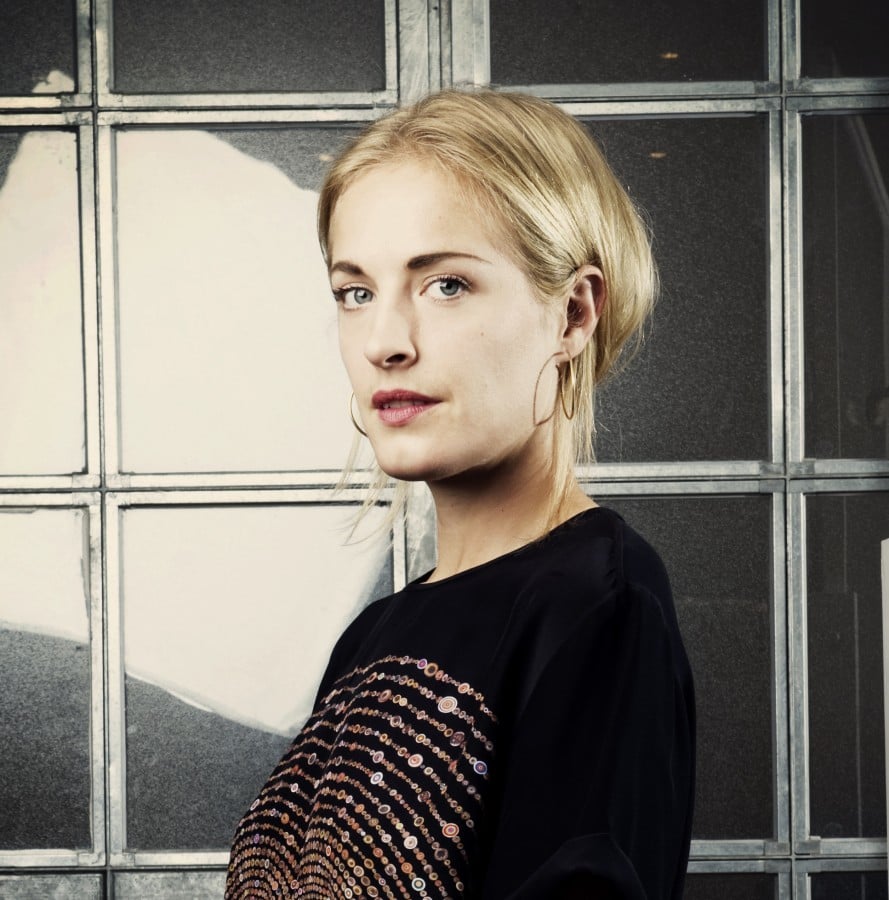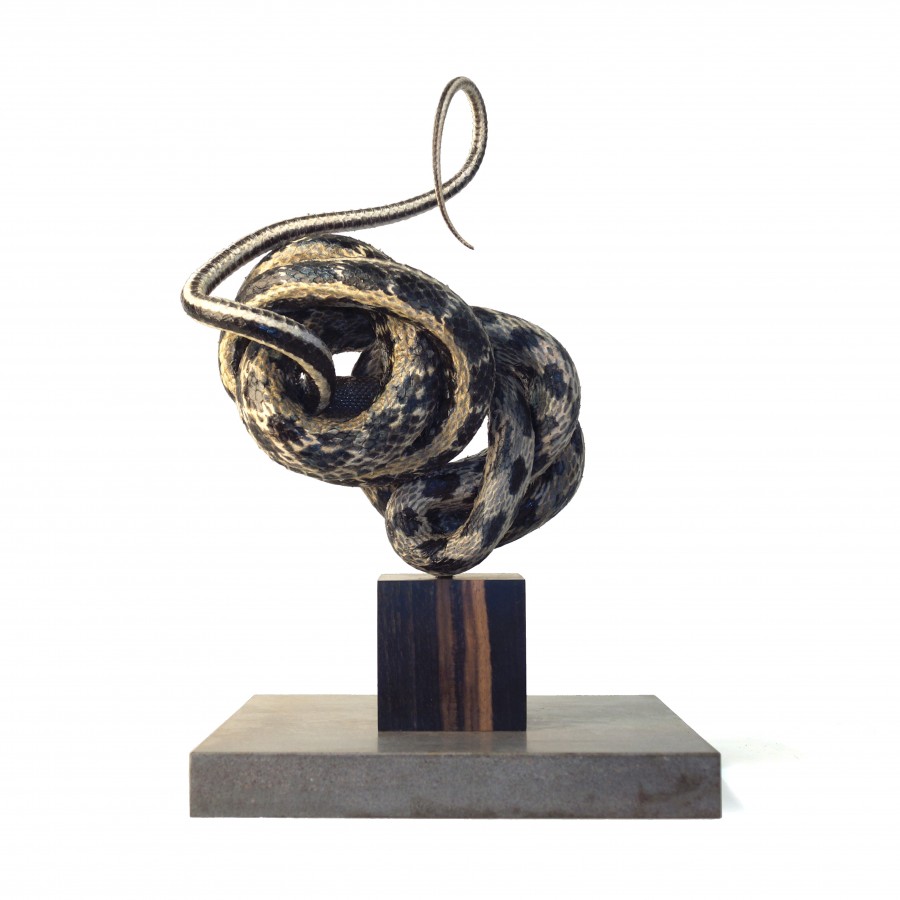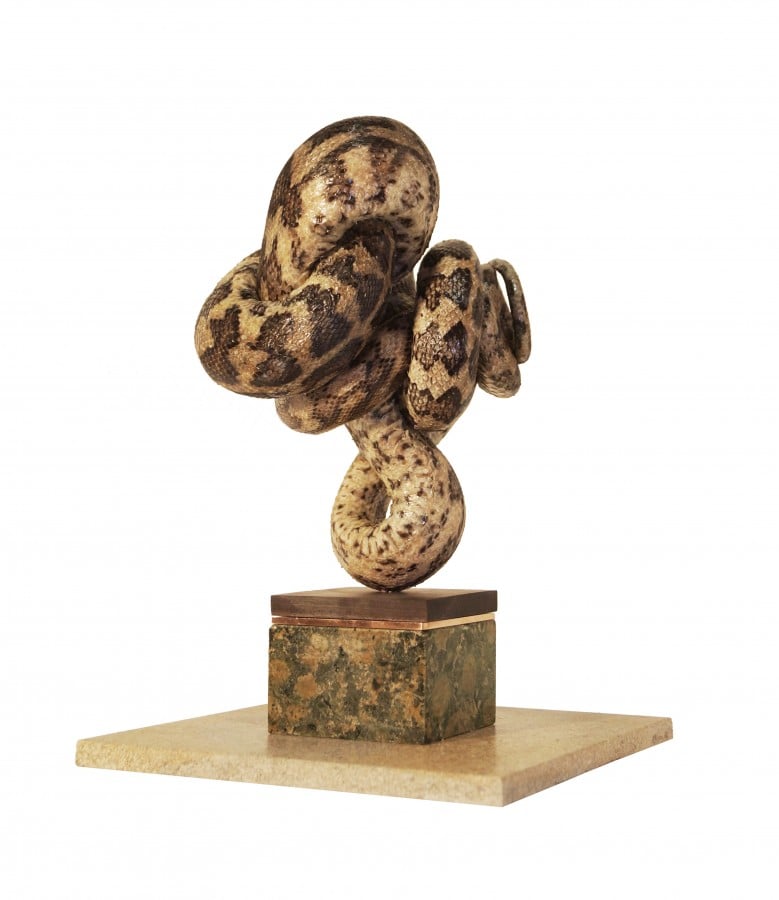On a gloomy and macabre rainy day over the vacation, I found myself being led down into the basement studio and workspace of Polly Morgan, arguably the most famous taxidermy-artist in Britain. Having only recently moved into this new space from her old studio in Hackney, she apologises for ‘not really having anything to show me’ (most of her work is in boxes waiting to be unpacked) but as we walk in, the yellow and white heft of an albino python’s corpse defrosting on a worktable catches my eye. A glimpse into one of her freezers reveals another row of sinuous and coiled cold bodies. ‘Nothing to show?’ I wondered. I had only just arrived and already I had been shown more of her ‘materials’ than I had bargained for.
Far from being a cold-hearted butcher itching to get her scalpel into her next corpse, she gives off an aura of warmth and affability, able to laugh at some of the more unconven- tional aspects of her profession. So obviously, my first question was, ‘why taxidermy?’
Initially studying English at Queen Mary University of London, Morgan graduated at 23 years old with the realisa- tion that her passion was not really in literature. Indeed, she was struggling to understand where her passion lay. While managing the Shoreditch Electricity Showrooms bar, she took courses in photography and journalism with the only outcome being that she learned that photography wasn’t for her and that she never wished to work in an office. She began to worry that for the rest of her life she would remain a ‘“jack of all trades, master of none.”
Then Morgan stumbled into taxidermy, merely trying it out once and finding herself captivated by it. After taking a day course from Scottish taxidermist George Jamieson, she knew she had found something that really gripped her. Speaking about her feelings about entering what was for her a previ- ously unexplored field she said, “I knew I could be fearless.”
Morgan was certainly unafraid to put her own personal twist on taxidermy. The art itself had fallen to the far reaches of conventionality and popularity since its heyday in the Vic- torian era, but Morgan, as well as many other contemporary artists, resurrected it from its cultural death much like she reawakens the corpses of the animals she works with. Her art features the bodies in uncanny situations, positions which recall scenarios that a viewer might briefly recognise com- bined with a completely foreign and sometimes unsettling element. When her artistic career was at its inception she had to scavenge for corpses, taking what she could get from vets and breeders. Earlier in her career, small birds and road-kill were easiest to acquire (Morgan has always kept from actively killing animals for the purposes of her art). An early work but one of her favourites, Still Birth, features a dead chick hang-
ing from a balloon suspended as if in flight in a glass bell jar. Birds have continued to feature in her work throughout her career but a thirst for new artistic challenges and greater fame have brought her the opportunities and desires to tackle new challenges. Morgan’s most recent works feature the bodies of snakes as twisting and twining sculptures, turning in on and over themselves and forming beautifully abstract still life images in the process.
With Morgan’s artwork, there seems to be a sense that the bodies are not revitalised but repurposed. They combine with the other mediums she uses to create her sculptures to form a more complex image than that of a traditional stuffed animal. Morgan hopes that her sculptures do remind people of things they have seen before but she insists that there isn’t a great deal to understand about her art. “The worst art,” she says, “is stuff like a one-liner.” She says she is not in the busi- ness of creating visual puns and it is not her mission to encode messages in her art. She claims a ‘synaesthetic instinct’ when it comes to creating art, an innate sense of the combination of the right texture, the right colour and the right use of space. Her art poeticises traditional taxidermy and renders it more aesthetically pleasing to the eye.
The general public might look at some of Morgan’s work and wonder what sort of depraved mind thought up such a thing, and she wouldn’t be able to enlighten them. “When I made them I couldn’t tell you what I was thinking,” she confesses and personally, part of me doesn’t care. The unexpected beauty to be found in death is quite pleasantly surprising enough to satisfy these eyes.
For Cherwell, maintaining editorial independence is vital. We are run entirely by and for students. To ensure independence, we receive no funding from the University and are reliant on obtaining other income, such as advertisements. Due to the current global situation, such sources are being limited significantly and we anticipate a tough time ahead – for us and fellow student journalists across the country.
So, if you can, please consider donating. We really appreciate any support you’re able to provide; it’ll all go towards helping with our running costs. Even if you can't support us monetarily, please consider sharing articles with friends, families, colleagues - it all helps!
Thank you!







